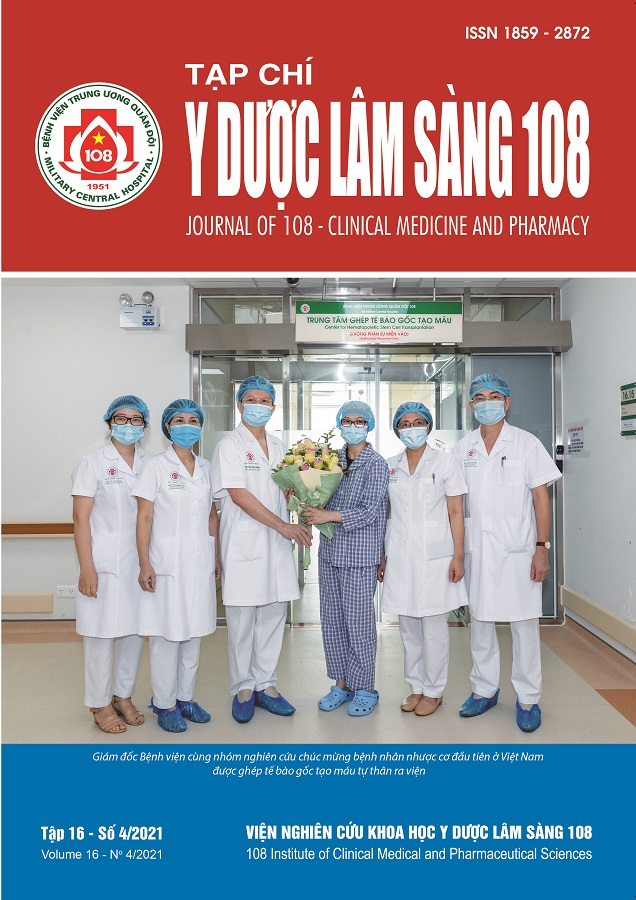Kết quả cắt khối tá tụy, vét hạch điều trị ung thư vùng đầu tụy
Main Article Content
Keywords
Tóm tắt
Mục tiêu: Đánh giá kết quả cắt khối tá tụy, vét hạch điều trị ung thư vùng đầu tụy. Đối tượng và phương pháp: Nghiên cứu mô tả, tiến cứu thực hiện trên những bệnh nhân ung thư vùng đầu tụy được phẫu thuật triệt căn tại Bệnh viện Trung ương Quân đội 108, trong khoảng thời gian từ tháng 6/2016 đến tháng 6/2019. Kết quả: Có 61 bệnh nhân với độ tuổi trung bình 60,2 ± 7,7 tuổi, vét hạch được tiến hành thuận lợi ở đa số các trường hợp. Kết quả phẫu thuật: Tốt: 44,3%; khá: 41%; trung bình: 11,5%; xấu: 3,3%. Tỷ lệ biến chứng chung theo Dindo là 55,7% (16,3% biến chứng nặng - từ độ III trở lên), rò tụy: 39,3%, chảy máu trong ổ bụng 11,5%, chảy máu tiêu hóa: 16,4%, chậm lưu thông dạ dày ruột 6,6%, tử vong phẫu thuật: 1,6%. Thời gian năm viện trung bình 18,6 ± 7,2 ngày. Thời gian sống thêm toàn bộ là 29,98 ± 2,54 tháng, tỷ lệ sống sau 1 năm và 3 năm lần lượt là 79,2 và 39,5%. Yếu tố liên lượng xấu của thời gian sống sau mổ là ung thư biểu mô tuyến tụy, phẫu thuật triệt căn R1 và di căn hạch. Kết luận: Cắt khối tá tụy vét hạch an toàn và khả thi trong giới hạn, kết quả xa cần được cải thiện nhiều. Các yếu tố ảnh hưởng tới kết quả xa được phát hiện bao gồm: Ung thư đầu tụy, phẫu thuật triệt căn R1 và di căn hạch.
Article Details
Các tài liệu tham khảo
2. Kathleen K. Christians, D.B.E., Sergio Pedrazzoli, Cosimo Sperti, Robert Beaulieu, Frederick Eckhauser, and Kendrick ML (2016) Resection for Neoplasms of the Pancreas. In Atlas of Upper Gastrointestinal and Hepato-PancreatoBiliary Surgery, P.-A. Clavien, Editor., Springer: Verlag Berlin Heidelberg: 831-871.
3. Chen JS et al (2019) Pancreatic fistula after pancreaticoduodenectomy: Risk factors and preventive strategies. Journal of Cancer Research and Therapeutics 15(4): 857.
4. Gao F et al (2016) Risk factors and treatment for hemorrhage after pancreaticoduodenectomy: a case series of 423 patients. Biomed Res Int 2016:2815693.
5. Melloul E et al (2020) Guidelines for Perioperative Care for Pancreatoduodenectomy: Enhanced Recovery After Surgery (ERAS) Recommendations 2019. World journal of surgery: 1-29.
6. Aziz K, Wolfgang CL, and Javed AA (2018) Operative complications and their management following resection for pancreatic and periampullary cancers, in surgery for pancreatic and periampullary cancer. Springer: 227-238.
7. Sperling J et al (2016) Extended versus standard lymphadenectomy in patients undergoing pancreaticoduodenectomy for periampullary adenocarcinoma: A prospective randomized single center trial. European Surgery 48(1): 26-33.
8. He J and Cameron JL (2018) Pancreaticoduodenectomy for Pancreatic Cancer, Short‐and Long‐Term Outcomes After Kausch-Whipple and Pylorus‐Preserving Resection. The Pancreas: An Integrated Textbook of Basic Science, Medicine, and Surgery: 783-789.
9. Wiltberger G et al (2018) Pancreaticoduodenectomy for periampullary cancer: Does the tumour entity influence perioperative morbidity and long-term outcome? Acta Chirurgica Belgica 118(6): 341-347.
10. Zakaria H et al (2020) Prognostic factors for long-term survival after pancreaticoduodenectomy for periampullary adenocarcinoma. A retrospective cohort study. Annals of Medicine and Surgery.
 ISSN: 1859 - 2872
ISSN: 1859 - 2872
